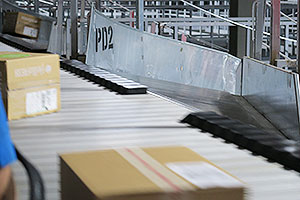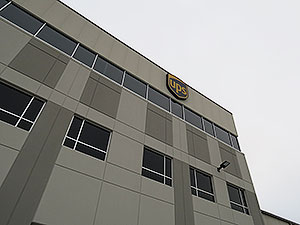Senior Reporter
UPS’ New Automated Sorting Facility in Atlanta Is Up and Running

ATLANTA — UPS Inc. is looking to the future with its new Southeast Metro Automated Routing Terminal.
The $400 million complex sits on 321 acres in an industrial park on this city’s west side, 20 miles from the company’s headquarters. About the size of 19 football fields, the automated facility can be expanded to increase the 1,700 packages a minute it is able to process now. It also will serve as a blueprint for future UPS ground centers.

Dozens of monitors in the control room show every conveyor belt and potential choke point. (Dan Ronan/Transport Topics)
Officials gave media members, including Transport Topics, an exclusive view of the operation, which now is the second-largest UPS ground hub in the United States, after the suburban Chicago facility.
“This strategic capital investment will feature state-of-the-art technology,” CEO David Abney said. “UPS is building flexibility to meet the growing needs of our customers and our business in Georgia, and around the world.”
UPS built the facility near a long-demolished public housing project, and it received an estimated $40 million in city and state tax credits and incentives.
“This is a neighborhood where we felt we could make a difference,” Abney said when it was announced the terminal would be built.
While planning had been underway for several years, construction didn’t begin until the winter of 2017. The facility officially opened in August as tractor-trailer drivers began bringing packages there to be sorted and reloaded to be sent to other distribution centers.
Oct. 20 will mark a milestone as UPS drivers are set to begin delivering packages from the facility to homes and businesses in the Southeast. UPS added Saturday delivery service more than a year ago.
The facility operates around the clock, and it is managed by about 20 engineers and technicians operating in a high-tech control room with video feeds from inside and outside, and dozens of monitors showing what is taking place along every conveyor belt and potential choke point.
“They have visibility to packages coming in, through our feeder lanes, our tractor-trailers that are coming on property,” UPS President of Plant Engineering Rhonda Clark said. “We know how many trailers are coming in, where they go, what doors, where they get located, if they are unloaded immediately or if it’s a load that should sit for a while.
“They make decisions about any kind of problems we may be having with the conveyor system inside the building, so if we have a jam that may be a problem with packages not sorting properly, they will address them from that area as well. It is an orchestrated dance to bring that all together to keep operations flowing, at the facility, both inside and out.”

Plastic "pucks" send packages in the proper direction. (Dan Ronan/Transport Topics)
UPS said the automated system of conveyor belts is 35% faster than sorting at other facilities, where much of the work is done manually. In Atlanta, each package zooms through a tunnel with multiple cameras that scan a bar code on each side of the box. The package’s bar code then triggers the movement of what UPS said are plastic “pucks” that bump, sort and direct the package into the proper direction and onto another conveyor belt and eventually to the correct truck to be loaded and delivered.
“The automation definitely adds to the efficiency. Because we use all of this efficient sorting equipment … we are much more accurate than we were when we used manual sorting operations,” Clark said. “We are more efficient because the automation moves at a much faster pace than our typical manual sorting. Our belts move at 600 feet per minute, which is really fast, 7, 8 miles per hour.”
UPS said the Atlanta operation will assist in relieving some of the pressure that has taken place at other facilities, and eventually 10% of all packages will be processed at this facility. The company said this will be helpful especially during the peak periods of November and December, when package volumes are expected to skyrocket because of the holiday shopping season. E-commerce is expected to increase to nearly $120 billion this year, up 15% from the same period in 2017, according to an analysis from the publication Internet Retailer. The U.S. Commerce Department said e-commerce sales grew 15.7% during the first half of 2018 compared with 2017.
UPS said it adopted an environmentally friendly approach during construction, especially since the site is just a few hundred yards from the Chattahoochee River, which supplies 70% of metro Atlanta’s water.

UPS' Southeast Metro Automated Routing Terminal in Atlanta. (Dan Ronan/Transport Topics)
UPS built a concrete plant on site so the aggregate material would not have to be brought in on hundreds of trucks. There also is a truck-washing facility that can reclaim nearly 30 million gallons of water a year. Fueling stations for diesel and compressed natural gas were built on site as part of the construction, and an electric charging station can be added as well.
When fully operational, the facility will need more than 3,000 employees, and UPS is still hiring. The company worked with Atlanta’s regional mass transit agency, MARTA, to have a bus stop on the property so employees can be taken to the nearest subway station.
UPS ranks No. 1 on the Transport Topics Top 100 list of the largest for-hire carriers in North America.




